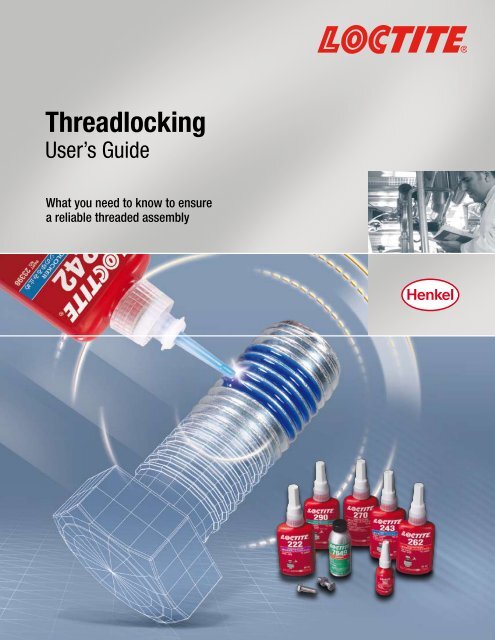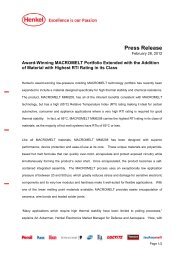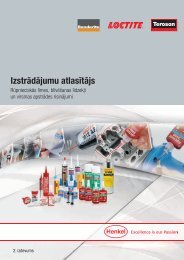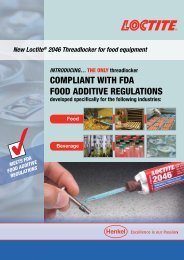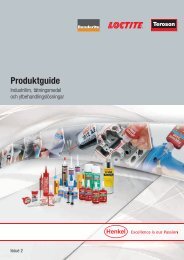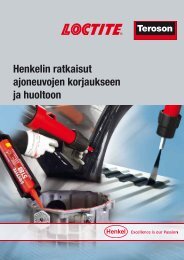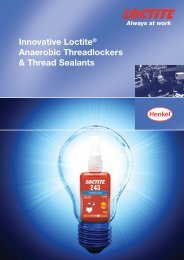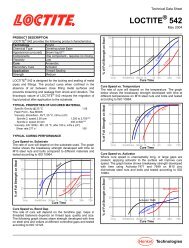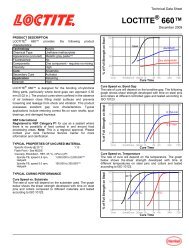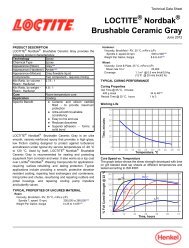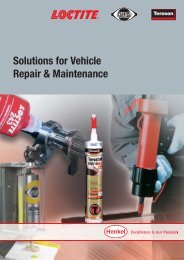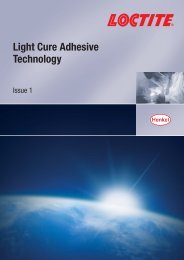Loctite Threadlocking Users Guide
Loctite Threadlocking Users Guide
Loctite Threadlocking Users Guide
Create successful ePaper yourself
Turn your PDF publications into a flip-book with our unique Google optimized e-Paper software.
<strong>Threadlocking</strong><br />
User’s <strong>Guide</strong><br />
What you need to know to ensure<br />
a reliable threaded assembly
<strong>Loctite</strong> ® – Finding a Better Way<br />
Since the design of threaded fasteners, engineers have<br />
been searching for the solutions to vibrational loosening.<br />
Vibration loosening of fasteners creates relability issues,<br />
unscheduled shutdown of equipment and additional costs.<br />
Old Way<br />
Mechanical Locking Devices<br />
Mechanical locking devices (e.g. split washers, nylon nuts) were<br />
invented to solve the common problem of loosening that occurs<br />
in most threaded assemblies. Although they were made for this<br />
purpose, they have several shortcomings.<br />
Shortcomings of Mechanical Locking Devices<br />
•• Loosen under vibration, thermal expansion and/or<br />
improper torque<br />
•• Do not seal threads<br />
•• Require extensive inventory of several shapes and sizes<br />
•• Prone to rust<br />
Better Way<br />
<strong>Loctite</strong> ® Threadlockers<br />
Invented fifty years ago by <strong>Loctite</strong> Corporation, now Henkel Corporation,<br />
this revolutionary method to lock and seal threaded fasteners with<br />
liquid anaerobic adhesives has found worldwide acceptance. Suited for<br />
a wide range of applications, from delicate electronic components to<br />
heavy industrial equipment, <strong>Loctite</strong> ® threadlockers have dramatically<br />
increased the reliability of threaded assemblies.<br />
Benefits of <strong>Loctite</strong> ® Threadlockers<br />
•• Lock nuts and bolts against vibration and thermal expansion<br />
•• Seal against corrosion and leakage<br />
•• Reduce inventory costs<br />
•• Suitable for all shapes and sizes of fasteners<br />
•• Act as a thread lubricant<br />
•• Maintain critical adjustments of the assembly<br />
•• No on-torque adjustments needed<br />
•• High chemical resistance
<strong>Loctite</strong> ® <strong>Threadlocking</strong> <strong>Guide</strong><br />
Table of Contents<br />
THREADED FASTENERS<br />
Functions of a threaded assembly................................................................................2<br />
Why do threaded assemblies fail?................................................................................2<br />
LOCTITE ® THREADLOCKING SOLUTIONS<br />
How does a <strong>Loctite</strong> ® threadlocker work? .....................................................................3<br />
How do I use a <strong>Loctite</strong> ® threadlocker?..........................................................................3<br />
Why use <strong>Loctite</strong> ® threadlockers?..................................................................................4<br />
<strong>Loctite</strong> ® threadlocker key selection factors...................................................................5<br />
Selectors chart.............................................................................................................6<br />
When should I use a <strong>Loctite</strong> ® primer?...........................................................................6<br />
APPLICATION CASES........................................................................................ 7, 8<br />
WE TRUST IN LOCTITE ® THREADLOCKING SOLUTIONS......................................9<br />
1
Threaded Fasteners<br />
Functions of a threaded assembly<br />
1. Create clamp force<br />
2. Maintain clamp force<br />
3. Allow disassembly<br />
Clamp<br />
Force<br />
Why do threaded assemblies fail?<br />
Clamp force is not maintained<br />
Threaded assemblies loosen because of:<br />
A. Gaps: In order to make the assembly possible, nuts and<br />
bolts must have some tolerance, which creates gaps<br />
between the threads.<br />
Parts tolerance<br />
B. Vibration & side-to-side movement: These gaps<br />
allow the parts to move from side-to-side when<br />
exposed to vibration.<br />
Vibration and loosening<br />
C. Expansion/contraction & loosening: Expansion and<br />
contraction can also cause side-by-side movement. This,<br />
in addition to vibration, leads to loosening and ultimately<br />
disassembly of parts.<br />
Stretching of the bolt beyond its yield point and thermal expansion/contraction of<br />
parts leads to lack of structural rigidity and relaxation of parts<br />
Disassembly is not always possible<br />
This failure happens because, in certain conditions,<br />
a nut and a bolt can seize together. This seizing<br />
effect is caused by:<br />
• Corrosion, rust, when dealing with:<br />
Humidity<br />
High temperatures<br />
Assembly of different metals<br />
(galvanic corrosion)<br />
• Galling (friction welding)<br />
Corroded assemblies can be difficult<br />
to take apart...<br />
...which can lead to broken bolts.<br />
2
How does a <strong>Loctite</strong> ® threadlocker work?<br />
Fill Gaps<br />
<strong>Loctite</strong> ® threadlockers are single-component adhesives that cure in the absence of air<br />
and in contact with active metal to form a tough thermoset plastic. They completely<br />
fill all voids between the interfacing threads, which makes the assembly an unitized<br />
component, prevents any movement between threads, and ultimately prevents<br />
loosening.<br />
<strong>Loctite</strong> ® <strong>Threadlocking</strong> Solutions<br />
<strong>Loctite</strong> ® threadlocker between the interfacing threads<br />
Seal Threads<br />
Another property of <strong>Loctite</strong> ® threadlockers<br />
is thread sealing. This property is especially<br />
important when assembling through-bolts in<br />
an oil reservoir or cooling jacket in order to<br />
keep the fluids sealed in and corrosion out.<br />
Examples of this application are common<br />
but not limited, to gearboxes and internal<br />
combustion engines.<br />
Engagement area of rusty bolt that did NOT have<br />
<strong>Loctite</strong> ® threadlocker applied<br />
Engagement area of rusty bolt that DID have <strong>Loctite</strong> ®<br />
threadlocker applied<br />
How do I use a <strong>Loctite</strong> ® threadlocker?<br />
Application Options<br />
IMPORTANT: To achieve<br />
optimum performance all<br />
parts must be clean and<br />
free of contaminants<br />
(e.g. oil, grease).<br />
For through holes For blind holes For post assembly<br />
(using <strong>Loctite</strong> ® 290)<br />
For overhead applications<br />
Dispensing Options<br />
For maximum convenience and<br />
productivity, <strong>Loctite</strong> ® threadlockers can<br />
be dispensed through <strong>Loctite</strong> ® dispensing<br />
systems.<br />
250 ml and 50 ml<br />
<strong>Loctite</strong> ® hand pumps<br />
<strong>Loctite</strong> ® integrated semiautomatic dispenser,<br />
dispense valve, and stationary dispense valve<br />
3
<strong>Loctite</strong> ® <strong>Threadlocking</strong> Solutions<br />
Why use <strong>Loctite</strong> ® threadlockers?<br />
Conventional<br />
Method<br />
LOCKNUTS<br />
SPRING WASHERS<br />
NYLON INSERTS<br />
TAB WASHERS / SPLIT PINS<br />
Problems<br />
• Double cost<br />
• Extra space<br />
• Re-torquing required<br />
• Seizing<br />
• Ineffective locking<br />
• Can damage contact<br />
faces<br />
• Large inventory<br />
• On-torque needed<br />
• Ineffective under severe<br />
vibration<br />
• Require good access<br />
• Should not be re-used<br />
• Expensive<br />
• Difficult production use<br />
• Expensive<br />
• Designed mainly to<br />
prevent loss of<br />
loosened nuts & bolts<br />
<strong>Loctite</strong> ® Solutions<br />
• Lower cost<br />
• Space saving<br />
• Seal against<br />
corrosion<br />
• 100% contact, no<br />
loosening<br />
• Positive locking<br />
• No damage, no corrosion<br />
• One bottle fits many sizes<br />
• Low on-torque<br />
• Effective even under<br />
severe conditions<br />
• Easy to apply<br />
• Allow parts to be re-used<br />
• Lower cost<br />
• Easy application<br />
• Lower cost<br />
• Use standard parts<br />
<strong>Loctite</strong> ® Benefits<br />
Better Performance<br />
• Reliable assembly: Not only locks against vibration,<br />
shock and thermal cycling but also seals against<br />
corrosion and galling<br />
• Easy disassembly using hand tools when low or<br />
medium grade formula is selected<br />
• Outperform locking devices: better clamp load retention<br />
compared to all mechanical locking devices<br />
Vibration loosening test<br />
Cost Savings<br />
• Failure: Reliable threaded assemblies reduces costly downtimes<br />
• Inventory: “One size fits all”, universally applicable for a wide range<br />
of fastener sizes<br />
• Processing: Ease of automation reduces assembly costs and<br />
increases throughput<br />
• Material Cost: Lower cost per unit compared to most locking<br />
devices<br />
Cost per locking application<br />
Clamp load in %<br />
Standard bolt w/ <strong>Loctite</strong> ® threadlocker<br />
Bolt w/ saw-toothed flange<br />
Nylon nut<br />
Bolt w/ DIN 6797 A tooth lock washer<br />
Bolt w/ DIN 127 A split ring washer<br />
Unsecured standard bolt<br />
Number of load cycles<br />
Note: Results from the Transverse Vibration Test (Junkers Machine) that assesses<br />
fasteners’ resistance to vibration loosening<br />
4
<strong>Loctite</strong> ® threadlocker key selection factors<br />
Strength<br />
••<br />
Low strength: Ideal for fasteners 260°C), hand tools, and disassembly while hot<br />
Application Methods<br />
Easy disassembly with hand tools when<br />
using Low & Medium Strength formulas<br />
••<br />
Pre-Dispensed: <strong>Loctite</strong> ® sticks semisolid formula can be applied beforehand on bolts that are waiting to be assembled<br />
••<br />
Pre-Assembly: Most <strong>Loctite</strong> ® liquid threadlockers are designed to be applied at the moment that parts will be assembled<br />
••<br />
Post-Assembly: Wicking grade formula can be applied on parts that are already assembled<br />
Materials Being Assembled<br />
®<br />
•• All <strong>Loctite</strong> Threadlockers: Metal-to-metal applications<br />
®<br />
•• <strong>Loctite</strong> 425 Assure : Plastic-to-plastic, plastic-to-metal applications<br />
<strong>Loctite</strong> ® threadlockers are available in many grades to satisfy a wide range of applications. To make grade selection easy, the<br />
grades are now color-coded to help you identify one threadlocker from the other.<br />
LOW STRENGTH THREADLOCKERS<br />
• Removable with hand tools<br />
• Adjustment screws<br />
• Calibration screws<br />
• Meters and gauges<br />
• Up to M6<br />
MEDIUM STRENGTH THREADLOCKERS<br />
• Removable with hand tools<br />
• Machine tools and presses<br />
• Pumps and compressors<br />
• Mounting bolts<br />
• Gear boxes<br />
• Up to M20<br />
HIGH STRENGTH THREADLOCKERS<br />
• Permanently assembly<br />
• Heavy equipment<br />
• Suspension bolts<br />
• Motor and pump mounts<br />
• Bearing cap bolts and studs<br />
• Up to M27 and larger diameters<br />
PENETRATING THREADLOCKERS<br />
• Removable with heat and hand tools<br />
• Preassembled fasteners<br />
• Instrumentation screws<br />
• Electrical connectors<br />
• Carburetors<br />
• Up to M14<br />
5
<strong>Loctite</strong> ® <strong>Threadlocking</strong> Solutions<br />
Selectors chart<br />
Criteria Product Colour<br />
Thread size upto Operating temperature<br />
Core liquid line:<br />
Low strength<br />
<strong>Loctite</strong> ® 222<br />
purple fluorescent<br />
M14<br />
-55°C to + 150°C<br />
Medium strength<br />
<strong>Loctite</strong> ® 243<br />
blue fluorescent<br />
M20<br />
-55°C to + 150°C<br />
High-medium strength<br />
<strong>Loctite</strong> ® 262<br />
red fluorescent<br />
M27<br />
-55°C to + 150°C<br />
High strength<br />
<strong>Loctite</strong> ® 270<br />
green fluorescent<br />
M27<br />
-55°C to + 150°C<br />
Specialty liquid line:<br />
Passive surfaces<br />
<strong>Loctite</strong> ® 2701<br />
green fluorescent<br />
M27<br />
-55°C to + 150°C<br />
High temperature<br />
<strong>Loctite</strong> ® 272<br />
red-orange<br />
M27+<br />
-55°C to + 230°C<br />
Wicking/Capillarity<br />
<strong>Loctite</strong> ® 290<br />
green fluorescent<br />
M14<br />
-55°C to + 150°C<br />
Semi-solid line:<br />
Medium strength<br />
<strong>Loctite</strong> ® 248<br />
blue fluorescent<br />
M20<br />
-55°C to + 150°C<br />
High Strength<br />
<strong>Loctite</strong> ® 268<br />
red fluorescent<br />
M20<br />
-55°C to + 150°C<br />
When should I use a <strong>Loctite</strong> ® primer?<br />
Speed up cure<br />
Significantly speed up the cure time of<br />
<strong>Loctite</strong> ® threadlockers when assembling<br />
metal parts that are cold, have large gaps<br />
or deep threads.<br />
Inactive metal assemblies*<br />
When assembling metal parts with inactive surfaces, <strong>Loctite</strong> ® primers are<br />
recommended to ensure proper performance of <strong>Loctite</strong> ® threadlockers.<br />
*Inactive Metals<br />
(Primers Recommended)<br />
Active Metals<br />
(Primers Optional)<br />
Plated Parts<br />
Anodized Aluminum<br />
Titanium<br />
Stainless Steel<br />
Galvanized Steel<br />
Zinc<br />
Pure Aluminum<br />
Cadmium<br />
Magnesium<br />
Natural or Chemical<br />
Black Oxide<br />
Magnetite Steel<br />
Inconel ®<br />
Silver<br />
Gold<br />
Iron<br />
Plain Steel<br />
Copper<br />
Brass<br />
Bronze<br />
Nickel<br />
Manganese<br />
Monel ®<br />
Kovar ®<br />
<strong>Loctite</strong> ® 7088 Primer<br />
<strong>Loctite</strong> ® threadlockers cure in the absence of air and presence of metal ions. When assembling inactive metal parts, which are<br />
low in metal ions, the use of <strong>Loctite</strong> ® primers are recommended to ensure proper performance of <strong>Loctite</strong> ® threadlockers.<br />
6
Application Cases<br />
König + Neurath AG<br />
Assemblies in seating furniture are subject to enormous forces of<br />
motion. König + Neurath AG uses threadlocking adhesives on various<br />
threaded joints in their products (seating furniture and workplace<br />
systems). Threadlockers <strong>Loctite</strong> ® 242 and 270 are applied to ensure<br />
improved strength, to enhance stability and extend the service life of<br />
the furniture.<br />
LEMKEN GmbH & Co. KG<br />
Agricultural machinery for soil cultivation is exposed to severe<br />
vibrational loading. The notched hollow disc on the left is attached<br />
to the frame and secured with a nut. The bearing mounted disc is<br />
used for loosening and mixing of soil. As the disc rotates at a high<br />
peripheral speed, <strong>Loctite</strong> ® threadlocker is applied to the locknut for<br />
additional protection to permanently resist self-loosening of the nut.<br />
Stuttgarter Straßenbahnen AG<br />
Thousands of passengers trust in the safety of SSB, the Stuttgart<br />
urban light rail transportation they use on a daily basis. SSB<br />
workshops are responsible for repair and maintenance of all<br />
vehicle components. To ensure reliable assemblies of axles, bogies,<br />
transmission and motor, numerous threaded fasteners are locked<br />
with <strong>Loctite</strong> ® 243 or 262.<br />
Gottwald Port Technology GmbH<br />
Gottwald Port Technology GmbH builds a wide range of different<br />
cranes from railway and harbour cranes to fully automated stacking<br />
cranes. Particularly high loads are encountered during loading<br />
and unloading, and the hoisting gear of a crane must be capable<br />
of withstanding these loads. For reliable, permanent operational<br />
readiness the threaded fasteners used to assemble the electric<br />
motor to the transmission are secured with <strong>Loctite</strong> ® 243.<br />
SCHOTTEL GmbH<br />
Threaded assemblies in ship propellers operate under severely<br />
adverse conditions, exposed to vibrations, water currents and<br />
corrosion processes. SCHOTTEL´s product line includes rudder<br />
propellers in the megawatt range. Such enormous dynamic loads<br />
require the use of <strong>Loctite</strong> ® threadlockers to resist self-loosening.<br />
In addition, the assemblies are sealed for permanent corrosion<br />
protection. <strong>Loctite</strong> ® products therefore contribute significantly<br />
to operational safety and extend the service life of underwater<br />
components.<br />
7
Application Cases<br />
Ehlebracht Slowakei s.r.o.<br />
A large portion of LCD and plasma monitors are mounted on rotating<br />
holders before being fixed to the wall. Ehlebracht Slowakei s.r.o.<br />
manufactures these mounting devices for the electronics industry. As<br />
these holders are often subject to numerous load cycles there is a high<br />
risk of self-loosening of the nuts and bolts. To counteract this problem,<br />
wicking grade threadlocker <strong>Loctite</strong> ® 290 is applied to the galvanized<br />
screw after assembly.<br />
Professional Barrier Systems Ltd.<br />
Professional Barrier Systems Ltd. manufactures the highly respected<br />
Extendor range of physical security devices for the protection of<br />
window and door openings. The systems feature retractable grilles<br />
which blend into door and window surrounds when they are not in use.<br />
From a security standpoint, preventing the barrier’s threaded locking<br />
mechanism from moving is a necessity. For this crucial task <strong>Loctite</strong> ®<br />
268 threadlocking stick is applied before assembling the parts.<br />
Hiller GmbH<br />
The decanter centrifuge has become a major processing tool in a wide<br />
range of applications, e.g. for the separation of waste water and rape<br />
seed. The environment is harsh and chemical resistance is needed for<br />
all parts of the centrifuge. For components such as the bowl, conveyor,<br />
base frame, housing and most of all the centrifuge drive it is very<br />
important to prevent loosening and corrosion of the fasteners to ensure<br />
reliability of the components. As a result, manufacturer Hiller GmbH<br />
uses <strong>Loctite</strong> ® threadlockers in many of their assembly applications.<br />
8
We trust in <strong>Loctite</strong> ® <strong>Threadlocking</strong> Solutions<br />
Interim<br />
Design<br />
<strong>Guide</strong>lines<br />
HILLER<br />
EHLEBRACHT<br />
SLOWAKEI s.r.o.<br />
9
<strong>Loctite</strong> ® Solutions<br />
When you choose the <strong>Loctite</strong> ® brand, you receive much more than a<br />
reliable assembly, you obtain a comprehensive solutions package:<br />
•• Wide product range<br />
•• Advanced training programs<br />
•• Engineering services<br />
•• Research and development<br />
•• Agency certification and approvals<br />
•• Local application assistance<br />
•• Global availability<br />
Henkel Asia-Pacific & China<br />
Headquarters<br />
Henkel (China) Co., Ltd.<br />
No. 928 Zhangheng Road<br />
Zhangjiang High-Tech Park, Pudong<br />
Shanghai, 201203, P.R.China<br />
Tel: +86-21-2891 8000<br />
Fax: +86-21-2891 8971<br />
Henkel Australia Pty Ltd.<br />
135-141 Canterbury Road<br />
Kilsyth, Victoria 3137, Melbourne<br />
Australia<br />
Tel: +61-3-9724 7200<br />
Fax: +61-3-9761 3986<br />
Henkel Adhesives<br />
Technologies India Pvt. Ltd.<br />
1, Airport Service Road<br />
Domlur Layout<br />
Bangalore 560071<br />
Karnataka, India<br />
Tel: +91-80-2535 7771<br />
Fax: +91-80-2535 7770<br />
Henkel Hong Kong Ltd.<br />
Units 807-810, 8/F Island Place Tower<br />
510 King's Road, North Point<br />
Hong Kong<br />
Tel: +852-2233 0000<br />
Fax: +852-2802 9995<br />
PT Henkel Indonesien<br />
Jalan Raya Jakarta Bogor Km 31.2<br />
Cimanggis Depok 16953<br />
Indonesia<br />
Tel: +62-21-8775 2196<br />
Fax: +62-21-870 1823<br />
Henkel Japan Ltd.<br />
Henkel Technology Center -<br />
Asia-Pacific<br />
27-7 Shin Isogo-cho<br />
Isogo-ku, Yokohama<br />
235-0017 Japan<br />
Tel: +81-45-758 1800<br />
Fax: +81-45-758 1851<br />
Henkel (Malaysia) Sdn Bhd<br />
46/F, Menara Telekom (South Wing)<br />
Jalan Pantai Baharu<br />
59200 Kuala Lumpur<br />
Malaysia<br />
Tel: +60-3-2246 1000<br />
Fax: +60-3-2246 1188<br />
Henkel Korea Ltd.<br />
11/F, Mapo Tower<br />
418 Mapo-dong, Mapo-gu<br />
Seoul, 121-734 Korea<br />
Tel: +82-2-3279 1700<br />
Fax: +82-2-3273 4663<br />
Henkel Philippines Inc.<br />
21/F, Asian Star Building<br />
2402-2404 Asean Drive<br />
Filinvest Corporate City<br />
Alabang Muntinlupa City 1781 Philippines<br />
Tel: +63-2-807 6992<br />
Fax: +63-2-850 4763<br />
Henkel New Zealand Ltd.<br />
2 Allens Road, East Tamaki<br />
PO Box 58 493, Greenmount 1730<br />
Auckland, New Zealand<br />
Tel: +64-9-272 6710<br />
Fax: +64-9-272 6735<br />
Henkel Taiwan Ltd.<br />
10/F, No. 866 Chung Cheng Road<br />
Chung Ho City, Taipei County 235<br />
Taiwan (R.O.C)<br />
Tel: +886-2-2227 1988<br />
Fax: +886-2-2226 8699<br />
Henkel (Thailand) Ltd.<br />
35/F, Central World Tower<br />
999/9 Rama I Road<br />
Khwaeng Patumwan<br />
Khet Patumwan<br />
Bangkok 10330, Thailand<br />
Tel: +66-2-209 8000<br />
Fax: +66-2-209 8008<br />
Henkel Singapore Pte Ltd.<br />
#03-01/02, Haw Par Technocentre<br />
401 Commonwealth Drive<br />
Singapore 149598<br />
Tel: +65-6266 0100<br />
Fax: +65-6266 1161<br />
Henkel Vietnam Co., Ltd.<br />
Room 1011, 10/F Giay Viet Plaza<br />
180-182 Ly Chinh Thang Street<br />
Ward 9, District 3, Ho Chi Minh City<br />
Tel: +84-290 5489<br />
Fax: +84-290 5490<br />
Henkel KGaA (Headquarters)<br />
Henkelstraße 67<br />
40589 Düsseldorf<br />
Germany<br />
Tel: +49-211 7970<br />
Fax: +49-211 7980<br />
www.loctite.com<br />
www.henkel.com<br />
Please contact us for assistance and recommendation on specifications and applications of these products.<br />
®All trademarks, except where otherwise noted, are the property of or used under license by Henkel Corporation.<br />
©Copyright 2008. Henkel Corporation. All rights reserved. LT-4985 (AP 06/2008)


